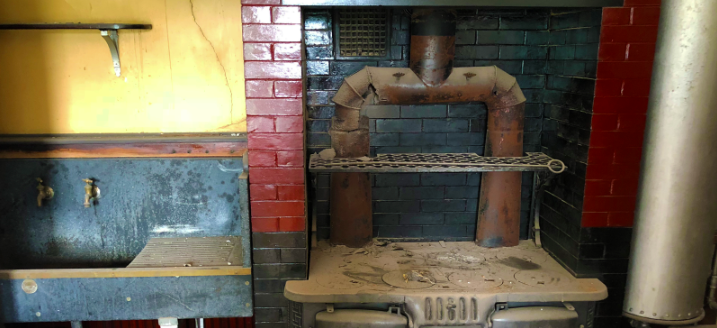
Workers renovating Edsall House last summer took down a wall and discovered a stove and sink that they believe dates to the late-19th century. Photo courtesy of Jim Ferranti
One day last summer, as Choate was in the middle of an extensive renovation of Edsall House, Project Manager Mr. James Ferranti uncovered an antique kitchen while moving walls from a first-floor bedroom. Ms. Alison Cady, Director of Strategic Planning and Communications, described the discovery as “buried treasure.” What hid behind the wall, for several years, was a partial kitchen, including a cast-iron skillet, a coal stove (likely original), a sink, and possibly a water-heating system. Mr. Ferranti was overseeing renovations this past summer on the senior boys’ dorm when they stumbled across this unexpected kitchen. “It was kind of confusing because there was just a large void in the wall,” said Mr. Ferranti. Regarding the date of the kitchen, he explained, “We don’t have a specific date, but we believe that it was built in the late 1800s.”
Edsall’s renovation was part of an ongoing renovation process: each summer, one or two dorms are renovated while students are away. Miraculously, it seems, Choate dormitories transform almost overnight. In Edsall, none of the rising seniors knew about the renovations until they arrived on campus. “Whatever the needs are, we’re trying to update them as perfectly as we can,” said Mr. Ferranti.
Mr. Ferranti worked alongside Mr. Mark Cappello, Director of Facilities, to carefully plan the Edsall renovation. They discover the scope of the project, create estimates, meet with an architect, and bid the project out to contractors. Timing is key — they have a precise schedule. According to Mr. Ferranti, they try to get contractors out by the Monday after students return home. Mr. Ferranti was instrumental during the construction itself — answering questions, guiding contractors, and keeping the project on track. There can be anywhere from three to fifteen Choate staff working on a single renovation. Last summer, they renovated East Cottage and Archbold; before that, Quantrell and CK; and even further back, Spencer and McCook. Regarding different dorm renovations, Mr. Ferranti said, “They’re all interesting in their own respects because you’re renovating an existing building — you never know what you’re going to find when you open up a wall.” There are several important factors to take into consideration while planning a dormitory renovation. First, there are financial constraints — the school must formally evaluate what projects they may fund. Second, there’s a practical, logistical component: the Choate Summer Programs are concurrently being housed. They must figure out when to take certain dorms offline without inconveniencing these students. Finally, there’s the mission-driven piece of the renovation cycle. “We also try to make sure that we’re doing the same thing in every dorm,” said Mr. Ferranti. This includes common rooms — their focus as of the past year — and constructing built-in closets and bathroom upgrades. “What we tend to do is collaborate with our colleagues in the Dean of Students’ Office and Residential Life,” said Mr. Cappello. “We know what’s going on in the building…if there’s deterioration or infrastructure. They know what’s happening with the students.” They must figure out a way, he said, to do “the most good possible.”
Renovations are intended to improve student and faculty living, so their input is key. In September or October, Mr. Ferranti sits down with students living in a dorm to host an open conversation. When renovating East Cottage, for instance, they learned that students could hear loud footsteps whenever somebody walked down the hall. This wasn’t uncommon in such an old building. Thus, Mr. Ferranti installed a noise dampening product and insulated the walls — their problem was addressed.
The Edsall kitchen “took several full-grown people to remove that — it was not a light piece of equipment,” said Mr. Ferranti. Ms. Cady and Mr. Ferranti have theorized that the kitchen was the result of some physical shortcoming. It’s possible, they think, that Edsall’s original renovator wasn’t strong enough to move the stove, so they just left it there. Mr. Ferranti approached several longtime facilities employees, some of which had worked at Choate for multiple decades; nothing had rivaled this discovery. Unfortunately, the equipment was beyond repair — it was immediately disposed of.
In terms of the future, Mr. Ferranti and his team have a longer-term plan to regularly renovate the dormitories. It’s almost a never-ending cycle — by the time that they’ve exhausted every dormitory, a new problem will arise. “Even if everything worked perfectly, they still might need to be refreshed,” said Ms. Cady. She called the renovation cycle a “living project.” They can’t always get to every problem, so they must attempt to address these withstanding issues during another summer, Mr. Ferranti explained. “After you go through five or six years of renovating all the dorms,” Mr. Cappello said, “you double-back to paint all the doors, or change the door hardware.”




